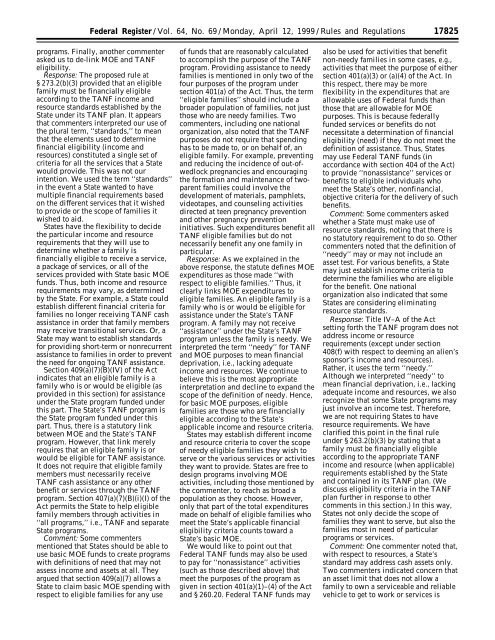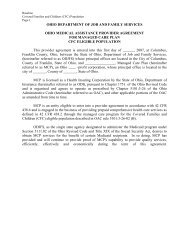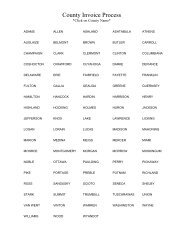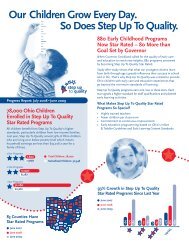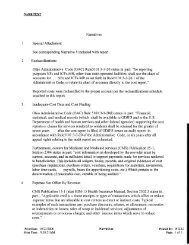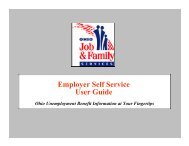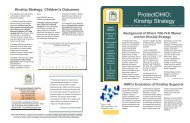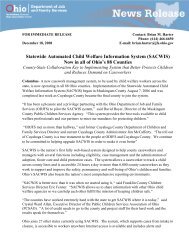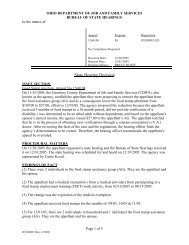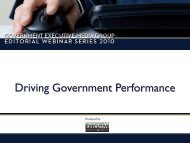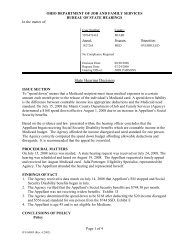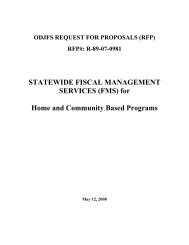Final TANF Rule as published in the Federal Register 4/12/1999
Final TANF Rule as published in the Federal Register 4/12/1999
Final TANF Rule as published in the Federal Register 4/12/1999
You also want an ePaper? Increase the reach of your titles
YUMPU automatically turns print PDFs into web optimized ePapers that Google loves.
<strong>Federal</strong> <strong>Register</strong> / Vol. 64, No. 69 / Monday, April <strong>12</strong>, <strong>1999</strong> / <strong>Rule</strong>s and Regulations<br />
programs. <strong>F<strong>in</strong>al</strong>ly, ano<strong>the</strong>r commenter<br />
<strong>as</strong>ked us to de-l<strong>in</strong>k MOE and <strong>TANF</strong><br />
eligibility.<br />
Response: The proposed rule at<br />
§ 273.2(b)(3) provided that an eligible<br />
family must be f<strong>in</strong>ancially eligible<br />
accord<strong>in</strong>g to <strong>the</strong> <strong>TANF</strong> <strong>in</strong>come and<br />
resource standards established by <strong>the</strong><br />
State under its <strong>TANF</strong> plan. It appears<br />
that commenters <strong>in</strong>terpreted our use of<br />
<strong>the</strong> plural term, ‘‘standards,’’ to mean<br />
that <strong>the</strong> elements used to determ<strong>in</strong>e<br />
f<strong>in</strong>ancial eligibility (<strong>in</strong>come and<br />
resources) constituted a s<strong>in</strong>gle set of<br />
criteria for all <strong>the</strong> services that a State<br />
would provide. This w<strong>as</strong> not our<br />
<strong>in</strong>tention. We used <strong>the</strong> term ‘‘standards’’<br />
<strong>in</strong> <strong>the</strong> event a State wanted to have<br />
multiple f<strong>in</strong>ancial requirements b<strong>as</strong>ed<br />
on <strong>the</strong> different services that it wished<br />
to provide or <strong>the</strong> scope of families it<br />
wished to aid.<br />
States have <strong>the</strong> flexibility to decide<br />
<strong>the</strong> particular <strong>in</strong>come and resource<br />
requirements that <strong>the</strong>y will use to<br />
determ<strong>in</strong>e whe<strong>the</strong>r a family is<br />
f<strong>in</strong>ancially eligible to receive a service,<br />
a package of services, or all of <strong>the</strong><br />
services provided with State b<strong>as</strong>ic MOE<br />
funds. Thus, both <strong>in</strong>come and resource<br />
requirements may vary, <strong>as</strong> determ<strong>in</strong>ed<br />
by <strong>the</strong> State. For example, a State could<br />
establish different f<strong>in</strong>ancial criteria for<br />
families no longer receiv<strong>in</strong>g <strong>TANF</strong> c<strong>as</strong>h<br />
<strong>as</strong>sistance <strong>in</strong> order that family members<br />
may receive transitional services. Or, a<br />
State may want to establish standards<br />
for provid<strong>in</strong>g short-term or nonrecurrent<br />
<strong>as</strong>sistance to families <strong>in</strong> order to prevent<br />
<strong>the</strong> need for ongo<strong>in</strong>g <strong>TANF</strong> <strong>as</strong>sistance.<br />
Section 409(a)(7)(B)(IV) of <strong>the</strong> Act<br />
<strong>in</strong>dicates that an eligible family is a<br />
family who is or would be eligible (<strong>as</strong><br />
provided <strong>in</strong> this section) for <strong>as</strong>sistance<br />
under <strong>the</strong> State program funded under<br />
this part. The State’s <strong>TANF</strong> program is<br />
<strong>the</strong> State program funded under this<br />
part. Thus, <strong>the</strong>re is a statutory l<strong>in</strong>k<br />
between MOE and <strong>the</strong> State’s <strong>TANF</strong><br />
program. However, that l<strong>in</strong>k merely<br />
requires that an eligible family is or<br />
would be eligible for <strong>TANF</strong> <strong>as</strong>sistance.<br />
It does not require that eligible family<br />
members must necessarily receive<br />
<strong>TANF</strong> c<strong>as</strong>h <strong>as</strong>sistance or any o<strong>the</strong>r<br />
benefit or services through <strong>the</strong> <strong>TANF</strong><br />
program. Section 407(a)(7)(B)(i)(I) of <strong>the</strong><br />
Act permits <strong>the</strong> State to help eligible<br />
family members through activities <strong>in</strong><br />
‘‘all programs,’’ i.e., <strong>TANF</strong> and separate<br />
State programs.<br />
Comment: Some commenters<br />
mentioned that States should be able to<br />
use b<strong>as</strong>ic MOE funds to create programs<br />
with def<strong>in</strong>itions of need that may not<br />
<strong>as</strong>sess <strong>in</strong>come and <strong>as</strong>sets at all. They<br />
argued that section 409(a)(7) allows a<br />
State to claim b<strong>as</strong>ic MOE spend<strong>in</strong>g with<br />
respect to eligible families for any use<br />
of funds that are re<strong>as</strong>onably calculated<br />
to accomplish <strong>the</strong> purpose of <strong>the</strong> <strong>TANF</strong><br />
program. Provid<strong>in</strong>g <strong>as</strong>sistance to needy<br />
families is mentioned <strong>in</strong> only two of <strong>the</strong><br />
four purposes of <strong>the</strong> program under<br />
section 401(a) of <strong>the</strong> Act. Thus, <strong>the</strong> term<br />
‘‘eligible families’’ should <strong>in</strong>clude a<br />
broader population of families, not just<br />
those who are needy families. Two<br />
commenters, <strong>in</strong>clud<strong>in</strong>g one national<br />
organization, also noted that <strong>the</strong> <strong>TANF</strong><br />
purposes do not require that spend<strong>in</strong>g<br />
h<strong>as</strong> to be made to, or on behalf of, an<br />
eligible family. For example, prevent<strong>in</strong>g<br />
and reduc<strong>in</strong>g <strong>the</strong> <strong>in</strong>cidence of out-ofwedlock<br />
pregnancies and encourag<strong>in</strong>g<br />
<strong>the</strong> formation and ma<strong>in</strong>tenance of twoparent<br />
families could <strong>in</strong>volve <strong>the</strong><br />
development of materials, pamphlets,<br />
videotapes, and counsel<strong>in</strong>g activities<br />
directed at teen pregnancy prevention<br />
and o<strong>the</strong>r pregnancy prevention<br />
<strong>in</strong>itiatives. Such expenditures benefit all<br />
<strong>TANF</strong> eligible families but do not<br />
necessarily benefit any one family <strong>in</strong><br />
particular.<br />
Response: As we expla<strong>in</strong>ed <strong>in</strong> <strong>the</strong><br />
above response, <strong>the</strong> statute def<strong>in</strong>es MOE<br />
expenditures <strong>as</strong> those made ‘‘with<br />
respect to eligible families.’’ Thus, it<br />
clearly l<strong>in</strong>ks MOE expenditures to<br />
eligible families. An eligible family is a<br />
family who is or would be eligible for<br />
<strong>as</strong>sistance under <strong>the</strong> State’s <strong>TANF</strong><br />
program. A family may not receive<br />
‘‘<strong>as</strong>sistance’’ under <strong>the</strong> State’s <strong>TANF</strong><br />
program unless <strong>the</strong> family is needy. We<br />
<strong>in</strong>terpreted <strong>the</strong> term ‘‘needy’’ for <strong>TANF</strong><br />
and MOE purposes to mean f<strong>in</strong>ancial<br />
deprivation, i.e., lack<strong>in</strong>g adequate<br />
<strong>in</strong>come and resources. We cont<strong>in</strong>ue to<br />
believe this is <strong>the</strong> most appropriate<br />
<strong>in</strong>terpretation and decl<strong>in</strong>e to expand <strong>the</strong><br />
scope of <strong>the</strong> def<strong>in</strong>ition of needy. Hence,<br />
for b<strong>as</strong>ic MOE purposes, eligible<br />
families are those who are f<strong>in</strong>ancially<br />
eligible accord<strong>in</strong>g to <strong>the</strong> State’s<br />
applicable <strong>in</strong>come and resource criteria.<br />
States may establish different <strong>in</strong>come<br />
and resource criteria to cover <strong>the</strong> scope<br />
of needy eligible families <strong>the</strong>y wish to<br />
serve or <strong>the</strong> various services or activities<br />
<strong>the</strong>y want to provide. States are free to<br />
design programs <strong>in</strong>volv<strong>in</strong>g MOE<br />
activities, <strong>in</strong>clud<strong>in</strong>g those mentioned by<br />
<strong>the</strong> commenter, to reach <strong>as</strong> broad a<br />
population <strong>as</strong> <strong>the</strong>y choose. However,<br />
only that part of <strong>the</strong> total expenditures<br />
made on behalf of eligible families who<br />
meet <strong>the</strong> State’s applicable f<strong>in</strong>ancial<br />
eligibility criteria counts toward a<br />
State’s b<strong>as</strong>ic MOE.<br />
We would like to po<strong>in</strong>t out that<br />
<strong>Federal</strong> <strong>TANF</strong> funds may also be used<br />
to pay for ‘‘non<strong>as</strong>sistance’’ activities<br />
(such <strong>as</strong> those described above) that<br />
meet <strong>the</strong> purposes of <strong>the</strong> program <strong>as</strong><br />
given <strong>in</strong> section 401(a)(1)–(4) of <strong>the</strong> Act<br />
and § 260.20. <strong>Federal</strong> <strong>TANF</strong> funds may<br />
17825<br />
also be used for activities that benefit<br />
non-needy families <strong>in</strong> some c<strong>as</strong>es, e.g.,<br />
activities that meet <strong>the</strong> purpose of ei<strong>the</strong>r<br />
section 401(a)(3) or (a)(4) of <strong>the</strong> Act. In<br />
this respect, <strong>the</strong>re may be more<br />
flexibility <strong>in</strong> <strong>the</strong> expenditures that are<br />
allowable uses of <strong>Federal</strong> funds than<br />
those that are allowable for MOE<br />
purposes. This is because federally<br />
funded services or benefits do not<br />
necessitate a determ<strong>in</strong>ation of f<strong>in</strong>ancial<br />
eligibility (need) if <strong>the</strong>y do not meet <strong>the</strong><br />
def<strong>in</strong>ition of <strong>as</strong>sistance. Thus, States<br />
may use <strong>Federal</strong> <strong>TANF</strong> funds (<strong>in</strong><br />
accordance with section 404 of <strong>the</strong> Act)<br />
to provide ‘‘non<strong>as</strong>sistance’’ services or<br />
benefits to eligible <strong>in</strong>dividuals who<br />
meet <strong>the</strong> State’s o<strong>the</strong>r, nonf<strong>in</strong>ancial,<br />
objective criteria for <strong>the</strong> delivery of such<br />
benefits.<br />
Comment: Some commenters <strong>as</strong>ked<br />
whe<strong>the</strong>r a State must make use of<br />
resource standards, not<strong>in</strong>g that <strong>the</strong>re is<br />
no statutory requirement to do so. O<strong>the</strong>r<br />
commenters noted that <strong>the</strong> def<strong>in</strong>ition of<br />
‘‘needy’’ may or may not <strong>in</strong>clude an<br />
<strong>as</strong>set test. For various benefits, a State<br />
may just establish <strong>in</strong>come criteria to<br />
determ<strong>in</strong>e <strong>the</strong> families who are eligible<br />
for <strong>the</strong> benefit. One national<br />
organization also <strong>in</strong>dicated that some<br />
States are consider<strong>in</strong>g elim<strong>in</strong>at<strong>in</strong>g<br />
resource standards.<br />
Response: Title IV–A of <strong>the</strong> Act<br />
sett<strong>in</strong>g forth <strong>the</strong> <strong>TANF</strong> program does not<br />
address <strong>in</strong>come or resource<br />
requirements (except under section<br />
408(f) with respect to deem<strong>in</strong>g an alien’s<br />
sponsor’s <strong>in</strong>come and resources).<br />
Ra<strong>the</strong>r, it uses <strong>the</strong> term ‘‘needy.’’<br />
Although we <strong>in</strong>terpreted ‘‘needy’’ to<br />
mean f<strong>in</strong>ancial deprivation, i.e., lack<strong>in</strong>g<br />
adequate <strong>in</strong>come and resources, we also<br />
recognize that some State programs may<br />
just <strong>in</strong>volve an <strong>in</strong>come test. Therefore,<br />
we are not requir<strong>in</strong>g States to have<br />
resource requirements. We have<br />
clarified this po<strong>in</strong>t <strong>in</strong> <strong>the</strong> f<strong>in</strong>al rule<br />
under § 263.2(b)(3) by stat<strong>in</strong>g that a<br />
family must be f<strong>in</strong>ancially eligible<br />
accord<strong>in</strong>g to <strong>the</strong> appropriate <strong>TANF</strong><br />
<strong>in</strong>come and resource (when applicable)<br />
requirements established by <strong>the</strong> State<br />
and conta<strong>in</strong>ed <strong>in</strong> its <strong>TANF</strong> plan. (We<br />
discuss eligibility criteria <strong>in</strong> <strong>the</strong> <strong>TANF</strong><br />
plan fur<strong>the</strong>r <strong>in</strong> response to o<strong>the</strong>r<br />
comments <strong>in</strong> this section.) In this way,<br />
States not only decide <strong>the</strong> scope of<br />
families <strong>the</strong>y want to serve, but also <strong>the</strong><br />
families most <strong>in</strong> need of particular<br />
programs or services.<br />
Comment: One commenter noted that,<br />
with respect to resources, a State’s<br />
standard may address c<strong>as</strong>h <strong>as</strong>sets only.<br />
Two commenters <strong>in</strong>dicated concern that<br />
an <strong>as</strong>set limit that does not allow a<br />
family to own a serviceable and reliable<br />
vehicle to get to work or services is


